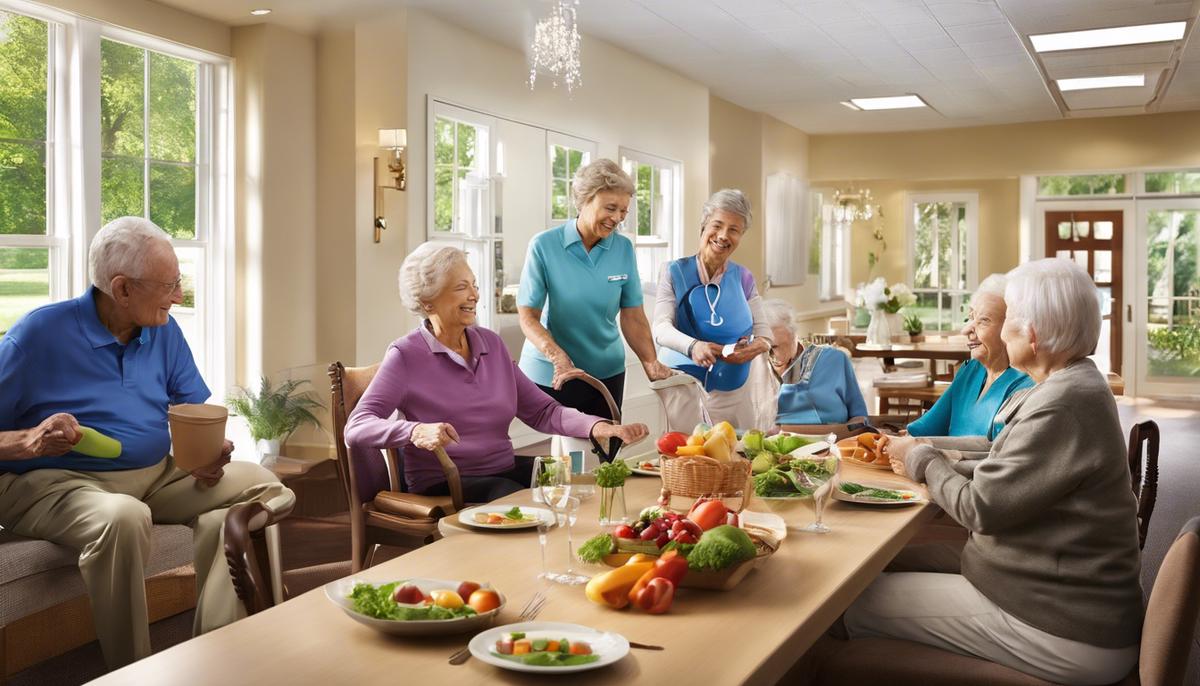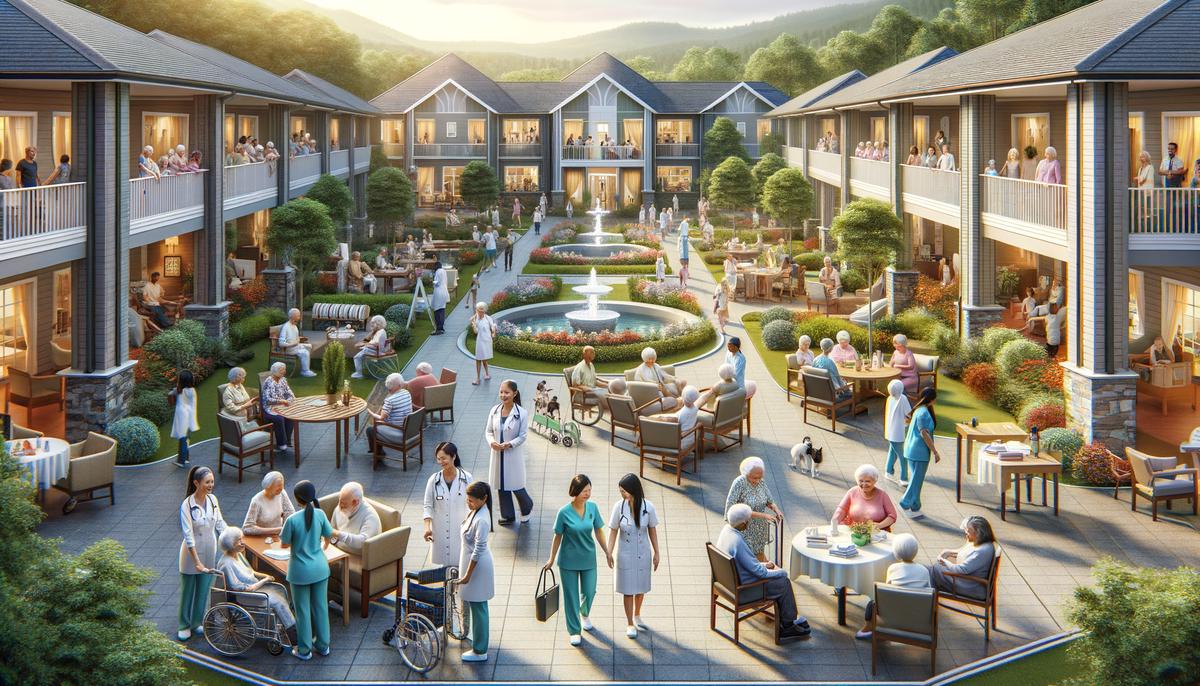Senior living communities play an essential role in nurturing the well-being of older adults, offering a supportive and enriched environment tailored to their needs. This article explores the multifaceted ways these communities contribute to the physical, mental, and emotional health of their residents, ensuring access to healthcare, and enhancing safety and security. Each segment sheds light on the dedicated services and thoughtful amenities designed to offer a higher quality of life for seniors, reflecting the comprehensive approach these communities take toward overall well-being.
Enhanced Physical Health
Living in a senior community can significantly boost physical health for older adults, catering to their unique needs and lifestyle. Here’s a closer look at how these environments are designed to promote physical well-being.
Access to Fitness and Exercise Programs
Most senior communities offer a variety of fitness programs tailored to older adults. From yoga and stretching to water aerobics and light weightlifting, these activities help maintain muscle strength, flexibility, and overall mobility. Participating in regular exercise not only helps in managing or reducing the risk of chronic diseases like heart disease and diabetes but also plays a crucial role in enhancing mood and reducing feelings of depression.
Nutritious Meal Plans
Proper nutrition is a cornerstone of good health, especially as we age. Senior communities typically provide well-balanced meals designed to meet the nutritional needs of older adults. These meals ensure residents get the vital vitamins, minerals, and other nutrients necessary to maintain energy levels and support physical health. For individuals with specific dietary requirements—such as low-sodium or diabetic-friendly meals—senior communities can offer specialized options to meet those needs.
Preventative Health Care and Monitoring
Many senior communities offer on-site health monitoring and preventative care services. Regular check-ups, medication management, and immediate access to health professionals contribute significantly to preventing health issues from becoming more severe. Early detection of potential health problems means quicker intervention, leading to better health outcomes.
Safe Environment to Reduce Accident Risks
A critical aspect of supporting physical health in senior living is providing a safe, accessible environment that minimizes the risk of falls and accidents. Senior communities are designed with this in mind, featuring grab bars in bathrooms, non-slip flooring, and emergency call systems. These features help older adults maintain their independence while ensuring they are safe and secure, thereby preventing injuries that could significantly impact their physical health.
Social Engagement Opportunities
While not directly physical in nature, the opportunity for social engagement in senior communities also significantly contributes to physical health. Social activities and friendships can encourage more active participation in physical activities and reduce the risk of isolation, which has been linked to poorer physical health outcomes. Engaging in community activities can lead to a more active lifestyle, indirectly supporting residents’ physical health.
Customized Care and Support
Finally, senior communities provide the added benefit of customized care and support. Whether it’s assistance with daily activities or more specialized healthcare needs, this support ensures that residents can manage their health effectively. For those with mobility issues or chronic health conditions, personalized care plans ensure they receive the support needed to participate in physical activities safely.
In summary, senior communities are uniquely positioned to support the physical health of older adults. Through a combination of fitness programs, nutritious meals, healthcare services, safe environments, social engagement, and customized support, residents can maintain and even improve their physical well-being, contributing to a higher quality of life as they age.

Mental and Emotional Well-being
Senior living communities play a crucial role in improving the mental well-being of seniors. These specialized environments are adept at addressing the multifaceted aspects of mental health, including emotional, social, and cognitive health, catering to the needs of older adults in a comprehensive manner.
Emotional Support Networks in Senior Living Communities create a strong sense of belonging among residents. These communities often staff dedicated professionals like social workers and counselors who provide emotional support and guidance. The presence of peers undergoing similar life stages also fosters a supportive environment where seniors feel understood and valued. Group activities and communal spaces encourage the sharing of experiences and feelings, making it easier for residents to form meaningful connections and friendships. This sense of camaraderie significantly reduces feelings of loneliness and isolation, common issues that can lead to depression and anxiety among seniors.
Cognitive Stimulation is another facet where senior living communities excel. Various programs designed to keep the mind active and engaged are a staple in these communities. Activities like memory games, puzzles, book clubs, and educational classes challenge the brain, helping to maintain cognitive function and potentially slow the progression of memory-related conditions such as dementia and Alzheimer’s disease. Engagement in these activities not only nurtures mental agility but also provides a sense of accomplishment and purpose, contributing positively to overall mental health.
Structured Routine and a Sense of Independence, albeit often overlooked, significantly affect mental well-being. Senior living communities provide a structured daily schedule that balances leisure and activities, imparting a reassuring sense of predictability and security. This routine, coupled with the support to maintain as much independence as possible, bolsters self-esteem and control over one’s life. Even with varying levels of care provided, the emphasis is always on enabling seniors to lead their lives with dignity and autonomy, contributing to a healthier mental state.
Spiritual and Cultural Enrichment programs tailored to the diverse backgrounds and beliefs of residents are vital components of senior living communities. These programs offer opportunities for meditation, worship, and cultural celebration, facilitating spiritual growth and fulfillment. Engaging in practices that align with personal beliefs and values strengthens mental peace and helps seniors find deeper meaning and satisfaction in their lives.
In conclusion, senior living communities are pivotal in promoting and enhancing mental health among older adults. Through emotional support, cognitive stimulation, a structured yet flexible routine, and spiritual enrichment, these communities provide a holistic approach to mental well-being. By prioritizing mental health as much as physical health, senior living communities are instrumental in ensuring the golden years are not just lived but are vibrant, engaged, and fulfilling.

Access to Healthcare Services
Senior living communities play a pivotal role in ensuring that their residents have timely access to healthcare. One of the foundational ways they accomplish this is through on-site medical services and partnerships with healthcare providers. This means that many senior living communities have medical staff, such as nurses or certified nursing aides, available on the premises. These professionals are equipped to provide first-line medical care or to swiftly address health concerns before they escalate into emergencies.
Furthermore, senior living communities often have formal relationships with local hospitals, medical centers, and specialized healthcare providers. Through these partnerships, residents gain easier access to a wide spectrum of medical services, ranging from routine check-ups to more specialized care. These relationships not only facilitate prompt medical appointments but also ensure a coordinated approach to each resident’s health care, enhancing the overall quality of medical attention received.
Telehealth services have also become an integral part of healthcare within senior living communities, particularly following the increased need for remote medical consultations. By utilizing telehealth, residents can have virtual doctor visits, thereby reducing the need to travel for medical appointments. This is especially beneficial for residents with mobility challenges or those who require regular monitoring of chronic conditions. Telehealth services ensure that residents receive timely medical advice and treatment, directly from their own living spaces.
Medication management is another critical aspect of healthcare in senior living communities. These communities employ systems and trained staff to assist residents with their medications, ensuring that they are taken correctly and at the appropriate times. This service is particularly important for residents who might find it challenging to manage complex medication schedules on their own. Proper medication management helps prevent drug-related complications and contributes to the overall well-being of the residents.
Senior living communities also emphasize preventative care measures. This includes regular health screenings and vaccinations, which are designed to catch potential health issues early on or prevent them altogether. By keeping a close eye on the health status of their residents, these communities can act swiftly to address any arising health concerns.
In addition to these specific healthcare services, the design and amenities of senior living communities also support the health and safety of residents. For instance, buildings are often equipped with features like handrails, emergency call systems, and barrier-free access to accommodate individuals with various levels of mobility. These thoughtful design elements minimize the risk of falls and injuries, thereby reducing the need for emergency medical care.
In summary, senior living communities provide a comprehensive approach to ensuring timely access to healthcare for their residents. Through on-site medical services, partnerships with healthcare providers, the integration of telehealth, effective medication management, preventative care, and safe living environments, these communities are dedicated to maintaining the health and well-being of their residents. This multifaceted approach allows senior living communities to cater to the unique healthcare needs of their population, ensuring that residents have the support they need to lead healthy and fulfilling lives.

Safety and Security Benefits
Senior living communities provide a secure setting that greatly contributes to the peace of mind for both residents and their families. These communities are designed with the safety and security of seniors in mind, offering a range of features and services that go beyond the basics of comfortable living. Let’s explore some of the key ways these communities enhance safety and security.
1. Controlled Access and Visitor Screening
Most senior living communities have controlled access, meaning not just anyone can walk in. Entrances are often staffed or require key card access, ensuring that only residents, staff, and authorized visitors can enter. Some communities also have visitor sign-in procedures and might even screen visitors to ensure the safety of residents. This controlled access helps protect residents from potential intruders and reduces the risk of theft or other security concerns.
2. Emergency Response Systems
Equipped with emergency response systems in each living unit and throughout the community, residents can quickly summon help if needed. Whether it’s a fall in the middle of the night or a sudden health concern, assistance is just a button press away. These systems are monitored 24/7, ensuring prompt response to any emergency.
3. Security Personnel and Surveillance
Many senior living communities employ security personnel who patrol the property and monitor surveillance cameras to deter crime and respond to any security incidents. The presence of security staff provides an additional layer of protection and peace of mind for residents and their families.
4. Safe Living Environments
Senior living communities are designed with safety in mind. This includes well-lit walking paths, handrails in hallways, non-slip flooring, and other features that minimize the risk of falls. Apartments or rooms are also designed to be easily navigable for those with mobility issues. These design choices can prevent accidents and ensure that seniors can move around their home and community safely.
5. Natural Disaster Preparedness
In areas prone to natural disasters, senior living communities have plans in place to protect residents. This might include reinforced buildings for hurricane-prone areas, evacuation plans for communities in wildfire regions, or generators to provide power during outages. Knowing that there’s a plan in place for such events can provide significant peace of mind.
6. Community Policies and Education
Senior living communities often have policies that promote safety and security, such as rules about locking doors or guidelines for safe use of community facilities. Residents may also have access to educational programs on topics like fraud prevention, online security, and personal safety. By staying informed and aware, seniors can better protect themselves against potential scams or threats.
In conclusion, senior living communities offer an environment that prioritizes the safety and security of their residents. From the physical design of the community to the policies and services in place, everything is focused on ensuring residents feel safe and secure in their homes. This thorough approach to safety and security is just another reason why senior living communities are a valuable option for seniors seeking a supportive and protective living environment.

Through the lens of senior living communities, we see a vivid picture of commitment to the health, happiness, and security of older adults. These communities extend beyond mere places of residence, embodying a holistic approach to care that touches every aspect of seniors’ lives. From fostering physical health and cognitive engagement to ensuring timely medical care and providing a safe, secure environment, senior living communities stand out as pillars of support. They not only enrich the lives of their residents but also offer peace of mind to families, knowing that their loved ones are in good hands. As society continues to evolve, the role of these communities remains crucial, ensuring that the golden years of life are not just about aging but about flourishing.
Leave a Reply